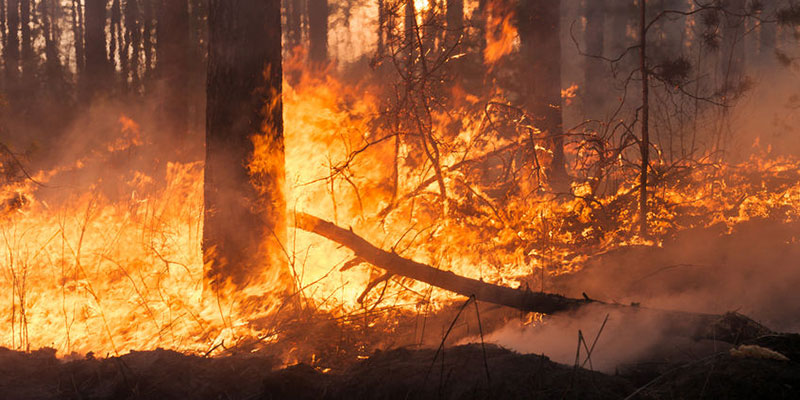Not even groundwater is immune to wildfire’s effects. Nutrients and carbon from wildfires can enter aquifers. Canopy losses also allow more evaporation, which interferes with natural aquifer recharge.
Dry conditions have a hand in the genesis of wildfires, and the fires in turn compromise the availability of freshwater resources
Close on the heels of the great Australian wildfires earlier this year, 2020’s cataclysmic fire season in the western United States has shattered records. Both the duration of fire seasons and the number of major wildfires have been increasing over recent decades. Beyond damage to property and loss of life, wildfires can alter the landscape over the long term and impact local drinking water resources, including forested watersheds.
Eighty percent of drinking water in 3,400 U.S. communities comes from forested watersheds. If those forests burn, wildfire runoff then becomes the drinking water source for the human population, fisheries, and aquatic ecosystems. In some cases, treating this polluted water can cost tens of millions of dollars.
The fires have been so widespread that it has been hard to quantify the season so far, but looking at data and news sources can provide a snapshot of the scale. For instance, in California this year, the tentative estimate for woodland burned through September 15 was more than 1.4 million acres, compared to a recent average of 345,204 acres for the same period.
Wildfire’s Effects on Surface and Groundwater
Ash in fire runoff may dangerously alter the chemistry of surrounding water bodies and reservoirs. After a wildfire, we see unpredictable amounts of elevated nitrates, organic carbon, major ions, metals, sediment, turbidity, temperatures, and stream flow, making water treatment a challenge.
In addition to water pollution caused by fire runoff, wildfire frequently interrupts electrical service, which can shut down water and wastewater treatment plants, and on occasion can even damage the facilities themselves, as happened with the Shaver Lake sewage treatment facility in California this year. Fires can even heat up underground municipal water pipes, causing toxic chemicals to leach from them into water supplies.
It’s common for wildfires to limit access to plants and monitoring infrastructure, and operators sometimes have little choice but to dip into lower-quality water sources, which can increase pretreatment costs.
In steep terrain, the changes wildfires bring to a watershed mean even a fairly mild rain event can trigger dangerous flash floods full of debris. As research hydrologist Jason Kean of the U.S. Geological Survey Landslide Hazards Program explained:
A debris flow is kind of like a flood on steroids […] It’s all bulked up with rocks, mud, boulders, and then it becomes a different animal.”
In September, the city of Cheyenne, Wyoming, was facing impacts to its main drinking water reservoir from wildfire runoff. This type of contamination not only threatens water quality, but can also shorten service lifetimes and raise maintenance requirements for reservoirs.
Not even groundwater is immune to wildfire’s effects. Nutrients and carbon from wildfires can enter aquifers. Canopy losses also allow more evaporation, which interferes with natural aquifer recharge. Without tree cover, the temperature of water in riparian zones may rise as much as 40 degrees, and fire sediment may impede stormwater’s percolation back into the ground.
Looking Beyond the 2020 Fire Season
The University of California Merced’s Sierra Nevada Research Institute (SNRI) has developed a method to determine the benefits of forest thinning and controlled burns on water yields and water stress. Because the economic benefits were not accurately determined in the past, the researchers hope the tool will spur investment in forest restoration and management.
Many wildfire challenges lie ahead. As Oregon’s governor Kate Brown put it:
It is the bellwether of the future. We are feeling the acute impacts of climate change. We are seeing its acute impacts in Oregon, on the West Coast and frankly in the entire world.
What can be done to temper some of the negative effects of wildfires on water supplies? With our Smart Packaged Aspiral™ wastewater treatment and NIROBOX™ water treatment plants, Fluence offers plug-and-play solutions that can come to the rescue when local water supplies are threatened by wildfire runoff.
These decentralized treatment plants are scalable to meet demand and quick to deploy and redeploy as requirements change. This approach minimizes risk since the units function independently: If one is damaged, the rest can still function and the damaged one is easily replaced.
Contact Fluence for the sustainable solutions to protect water resources in a landscape of increasingly common wildfires.

